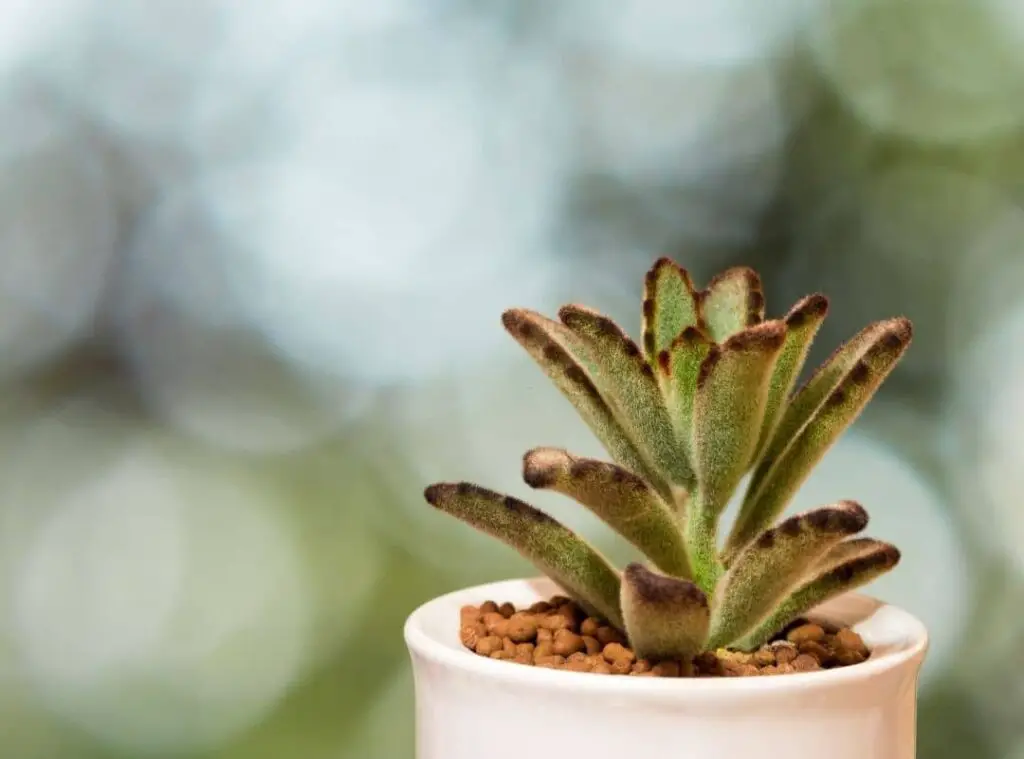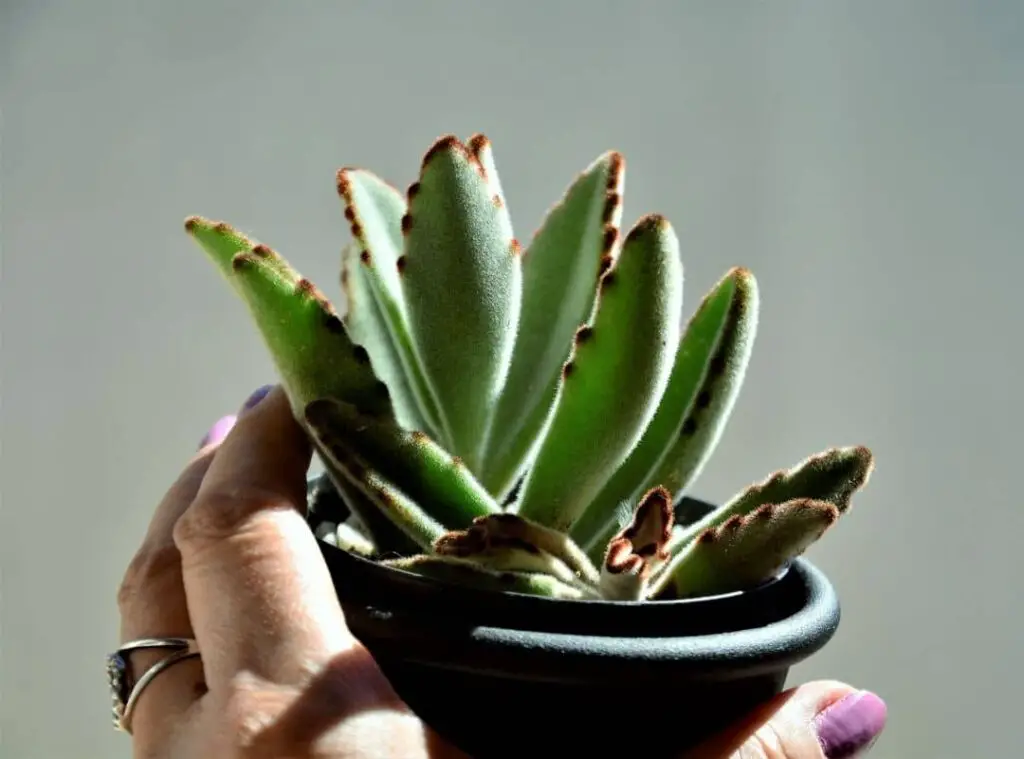Same as all succulents, panda plants also suffer from pest attacks and various kinds of diseases. That’s why I thought of writing this article about “ Panda plant problems”.
Let’s find various problems panda plants have to endure and treatment methods in this article.

What are panda plant problems?
Panda plants are generally resistant to diseases and to bug attacks. However, they could encounter some problems due to our faults and improper growing conditions we provide them.
Common problems of panda plants are droopy leaves, leaves falling off, leaves curling, turning yellowing, etiolation and wilting as well.
In addition to that, they will suffer from bug attacks from mealybugs, aphids, and scales etc.
Apart from that, succulents in general have a maximum lifespan, so do panda plants. Once they spend their full lifetime, they would perish.
However, whenever you spot any symptoms, best is to attend to those issues and treat them then and there. So! Let us find out in detail on these issues.
Panda plant leaves drooping
If you spot your panda plants leaves drooping, that could be mainly due to dry soil for a prolonged period.
It is true that panda plants could withstand the drought conditions for a longer period. However, they would still require some amount of moisture to help them survive.
As such, whenever you spot your panda plant leaves drooping, you need to attend to them as soon as possible.
As such when you do not supply water adequately for them, they would start drooping or even wilting.
In addition to that, you may see how the leaves’ edges are curling and end up turning yellow.
Ultimately, panda plants will start to drop their leaves just to reduce some surface which would evaporate water to the air.
If you wish to revive a droopy panda plant, first you need to take off the plant. After that you could submerge the nursery pot in which you had filled water for a 2-inch depth.
Next, leave the plant for a few hours so that it could soak up the water. It will take about 2-24 hours only to revive.
Further to avoid this condition, you need to water your panda plant moderately. Literally whenever you spot its soil is dry you need to commence watering it.
Having said that, you should not over water the plants. Unless it will create worse problems, You should water them less often during winter

leggy panda plant
Lack of sunlight is the root cause for the leggy panda plants. Once the panda plants run short of adequate levels of sunlight, they would try to lean towards a direction where they can absorb sunlight. Because of this, they would become leggy.
Whenever you come across such a situation, you need to immediately shift them to a bright sunny window.
Alternatively, you could consider repotting them as well. You need to repot them in spring only. Further when repotting, make sure that you are changing the pot to a slightly larger one.
Refrain from using pots which are too large as then it would retain excess water in the pot.
In addition to that, you could consider pruning the plant also. That would help to keep the plant short and dense foliage. You may use special scissors which would help you to trim the leaves as well as the stem.
Panda plant leaves falling off
You may have seen how the panda plant leaves are falling off. It could also be due to their natural growing pattern when their life span is almost over.
Additionally it could also be due to the faults you do. For example, if you over water them , they will tend to drop their leaves .
To ascertain whether over watering has caused this condition, you need to observe the soil condition and see whether it has excess water.
Only thing you could do to treat this is to cut back on watering and water them only when their soil is dry.
Over watering could be the biggest mistake you would make when growing them. That is simply because it could be lethal on the plant and chances are that you will lose your beloved plant as well.
Panda plant leaves curling
You could easily identify when your panda plant leaves are curling. It could happen due to so many reasons.
Over-watering could be one of these reasons which causes this condition. This is a quite commonly spotted reason which could cause this.
When I say over watering, it could be either the excess amount of water you provide them, or it could also be not growing them in the right soil mix.
When they are in their dormancy, you need to cut back on watering. In terms of the soil mix, it is mandatory that you provide them a fast-draining soil mix.
Ideally it has to be a gritty cactus and succulent mix. Having said that, you need to make sure that you are watering the plants only when their soil is dry.
Apart from over watering, lack of adequate level of sunlight could also cause these plants’ leaves to curl. It is important that you provide sufficient sunlight throughout the day for them.
Best is to provide them indirect sunlight for several hours daily. On the other hand, they would love to have full sunlight for some time too.
Avoid exposing them to full sunlight for prolonged periods though. Moreover, ensure that it is not too heated too.
Even when the sunlight condition changes during later months of the year,in that case you need to make sure that you let these plants gain at least six hours of sunlight.
Unless chances are that your plant leaves will curl. Further they would even tend to stretch towards a lighting source where they can get sunlight.
To remedy it, particularly when you are growing them as indoor plants, you need to make sure that you supplement them with a grow light.
Alternatively, you may shift them to somewhere where they could gain bright sunlight. If you have grown them as outdoor plants, you need to place them in a place where it could get sufficient light daily.
On the other hand, the temperature should not be more than 70 degrees Celsius. If you adhere to these guidelines, you could get rid of this condition.
Thirdly, it could also be due to transplanting shock. Chances are that your roots would probably get harmed during repotting and that could lead to this condition.
Further, if you are using a way too small sized pot, panda plant roots would find it difficult to find room to spread out and grow. Consequently, they would fail to form a vigorous root system.
Finally, if you are not using the right soil mix, that could also lead to this condition. As such it is important to realize where you made the mistake and attend to them and rectify those issues immediately.
Once you correct these, you will be rewarded with one fine panda plant, and you will feel so accomplished.

Overwatered panda plant
if you had overwater your panda plant, chances are that your plants stem, and leaves would come up with black spots.
There could be situations where you will not be able to revive the plants when they suffer from over watering.
Having said that, you could still trim the healthy leaves and use them for the propagation process. When you propagate them, first let those cut ends become callous and only after that you can grow them in a fresh soil mix which is fast draining.
If you do that you could at least have a new plant even though you lost the mother plant.
Further, if you spot any yellow and mushy leaves, over watering would have caused those conditions too.
You need to keep in mind that if your panda plant leaves are turning mushy, that is an early indication of root rot.
So, if you notice in the earlier stage and if you attend to it quickly, you could save the plant without much damage.
You need to skip on watering them and let them dry entirely. If you are still unsure, you could wait for a couple of days more.
Keep in mind that under watering could create less damage to the plant than what it does from over watering.
Further, you could take off the mushy leaves whenever you spot any as that will avoid any further potential spread of the rot.
Panda plant wilting
If your panda plant is running short of adequate water, that would cause your plants to wilt. To remedy this you may immediately start watering them.
When you water them, make sure that soil is moist, and the excess water is draining from the draining holes.
Pest and diseases
When it comes to pests’ issues with panda plants, mealybugs are the most spoken bug. They are gentle body insects, and they would love to occupy the panda plants.
Mealybugs generate a powdery substance, and it is quite like the color of the leaves of these plants.
As such it is important that you keep these plants under your observation so that you could detect these white little creatures if there are any.
In case the mealy bugs attack is on a minor level, you may pick them manually and clean the plant.
If the infection is on a severe level, you could consider adding a natural predator like ladybugs as they would feed on mealybugs.
Instead of them, you may also use 70 % isopropyl alcohol and neem oil to get rid of them.
Conclusion
Panda plants are unique plants which you could easily take care. As long as you care for them properly and provide them the right growing conditions, they will reward you with such beautiful plants. Further you will not encounter the aforesaid problems at any given time too.
If you are wondering about a plant to start off gardening or thinking of suggesting a plant for your kid to start off gardening, you may easily go ahead with this plant.
You only need to make sure that you do not over water them or let your pets hang around the plant.
Read Next: Does Panda Plant Flowers? | 8 Rare Facts About A Rare Event
Read Next: Is Panda Plant Toxic? | 10 Shocking Facts You Should Know |
Read Next: Kalanchoe Tomentosa Varieties | 7 Super Cute Plants With More Facts |
